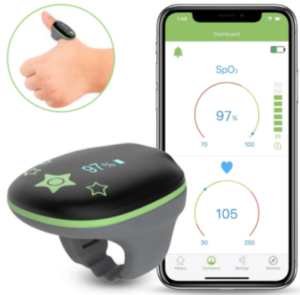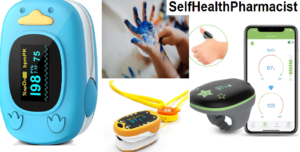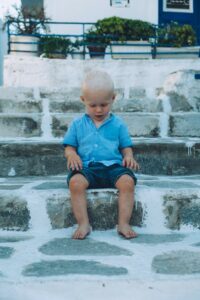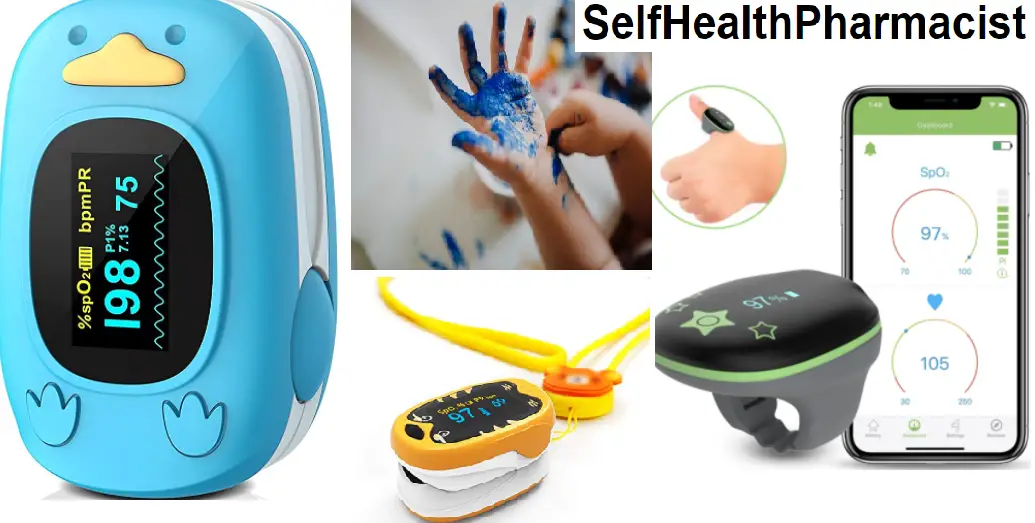Now more and more often you can see on sale devices aimed at monitoring the state of the body, not only in hospitals, but also at home.
This is a good trend, because due to the availability of convenient and easy-to-use products, you can notice the onset of the disease even before the appearance of serious symptoms and complications.
Children’s pulse oximeters are among the devices that must be in clinics, hospitals, ambulance teams and at home, especially if babies are prone to respiratory diseases, they have heart or lung problems.
In a Hurry? My Fast Answer is
Let me tell you about the Wellue O2Ring – it’s like the superhero of pulse oximeters, seriously!
One of the coolest things about it is that it doesn’t just clip onto your finger like your average oximeter.
Nope, it’s a smart ring that you wear on your finger, making it super comfortable and convenient. You won’t even feel like you’re wearing anything special, yet it’s working its magic behind the scenes.
What sets the Wellue O2Ring apart from the pack is its continuous monitoring feature.
Most pulse oximeters just give you a snapshot of your oxygen saturation and heart rate, but this bad boy keeps tabs on your levels around the clock.
Whether you’re chilling on the couch, out for a jog, or catching those Z’s, it’s right there with you, providing real-time data.
Oh, and speaking of data, this thing doesn’t just show you numbers – it visualizes your trends over time too.
Imagine having a personal health diary that tells you when you’re acing life and when you might need to take it easy. It’s like having a health-conscious buddy right on your finger!
If you’re already itching to get your hands on the Wellue O2Ring (or, well, your finger in this case), I’ve got you covered.
Table of Contents
Best Pulse Oximeter for Your Child Alternatives
Wellue KidsO2 |
 |
Portable pulse oximeter MD300K with cuff sensor |
|
The compact Alarm Child pulse oximeter PC-60NW |
|
GadgetMarket Fingertip Oxygen Monitor |
|
Children Fingertip Pulse Oximeter Blood Oxygen Saturation Monitor for Child Kids |
|
Best Pediatric Pulse Oximeter
Wellue O2 Ring
The Wellue O2 ring has accurate tracking of all indicators.
Oxygen levels and heart rate are tracked more frequently (every second).Analysis reports can be printed for sharing with your physician.

WellueO2 ring makes your life easier because It provides you with a free PC software and free app where you can share your PDF/CSV Files with the Doctors who can easily consult you.
This pulse oximeter collects and gives an impressive amount of necessary data during one recording session, as it continuously tracks oxygen levels, pulse rate, and motion every second. Continuous Monitoring is a feature that is very important too.
Can you use a pulse oximeter on a child?
The control and diagnostic medical device “pulse oximeter” is used when it is necessary to determine the degree of saturation of capillary blood with oxygen of a child.
With its help, while at home, it is possible to detect hypoxia in a timely manner, thereby preventing its negative consequences in patients at risk of developing oxygen starvation of children. As a rule, this condition is observed in the following cases:
- The rehabilitation period after myocardial infarction, post infarction cardiosclerosis;
- With progressive angina;
- Blood diseases;
- Heart rhythm disorders;
- With chronic diseases of the respiratory system.
- Hypoxia is quite dangerous in newborns.
Types of pulse oximeters for Children
Regardless of the age of patients, devices for measuring the level of SPO2 in human blood are household and stationary.
Especially for them, sensors are being developed that are used to apply to a child’s finger, a child’s foot, and an earlobe. Sensors are placed in those places where the pulse is well felt.
The most popular are the clip sensor and the earlobe clip sensor. In medical institutions, stationary devices are used.

They are used once, or as often as monitoring pulse oximetry is needed. The device measures heart rate and the percentage of oxygen saturation in the blood of children.
Normally, the indicators should reach 95-98%. If the saturation of children is below 90%, emergency care is required.
This condition is possible with severe hypoxia, obstructive pulmonary diseases, and significant blood loss.
How does a children pulse oximeter work?
Almost all devices whose work is aimed at determining the saturation of blood with oxygen, the principle of operation is the same.
Each device contains a sensor that emits infrared light. The beam, passing through soft tissues, is absorbed by the blood, and the degree of absorption depends on how oxygenated the blood is.
The microprocessor built into the device processes the received data, displaying the result on the screen.
Sensors in the form of a trailer are put on a child’s finger. Any pulse oximeter works according to this principle, no matter what you take: children’s finger, adult shoulder, network, used in hospitals.
The differences are only in the nozzle and the type of food. Most often, household appliances consist of two parts connected by a hinge.
Between them is a notch where a finger is placed. The measurement is carried out by pinching the finger. The screen displays readings on the level of saturation (SPO2) and pulse.
Some models have the ability to display a graph of the pulse wave perfusion index.
How should parents choose a children’s pulse oximeter?
By choosing any device, you must be sure that you can immediately use it, being anywhere: at home, on the street, in the car.
You will not need to pierce the skin to get to the blood or strictly follow the laboratory conditions.
Even if you do not have a medical education, you can easily determine the level of saturation in the blood of your baby and promptly seek medical help if necessary.
Children’s devices are equipped with such additional functions as:
- Sound notification if the indicators differ from the norm;
- Show the pulse chart.
Main Features of Children Pulse Oximeters
The portable pulse oximeter for newborns can be used to monitor the blood oxygen levels of even the tiniest babies.
Having such a device at home, it is possible to measure the level of oxygen at home, which saves parents from the need to regularly visit a medical laboratory with their child that performs control blood measurements. Pulse oximeters intended for newborns have the following features:
- Bright design that distracts the attention of the child.
- Display with large numbers.
- Giving an alarm signal in case of incorrect fixing, excluding the possibility of inaccurate measurements.
- The convenience of use.
- High mechanical strength.
Best pulse oximeter for kids
Popular models of children’s devices that measure blood saturation
1.Wellue KidsO2

The ring would be amazing for kids 3-10 years old. The ring can be adjustable for any child hand size, requirements and preference.
It is the best Top Pulse Oximeter ring for kids. This pulse oximeter is a ring that continuously Track Children’s Blood Oxygen Levels With Audio Reminder In App. Audio reminders for low blood oxygen in mobile APP & devices can catch the attention of adults.
The tracker ring is an additional device for monitoring the health of seniors with heart and lung diseases and sleep apnea attacks. This pulse oximeter is a sleeping tracker as well and it has a built-in vibration alert system for changes in blood oxygen levels and heart rate for user feedback.
And also O2 Ring uses Bluetooth Low Energy to connect to the phone.
It is a great device for children because it is not slippery and a child can not simply lose the ring. It has free software and you can share the child’s reports with doctor PDF/CSV analysis reports.
2.Portable pulse oximeter MD300K with cuff sensor
Portable pulse oximeter MD300K with cuff sensor is suitable for infants.
It has the following features: the presence of a visual and audio alarm mode, which can be set to a specific range. The screen displays data such as SPO2, heart rate, pulse bar, pulse tone.
It is possible to transfer a child’s data to a PC using the USB port. There is a low battery indication, a shutdown sensor, if the device is not in use, the sensor is triggered if the device has slipped from the finger.
3.The compact Alarm Child pulse oximeter PC-60NW
This model has a bright LED display that allows you to see the readings of the pulse and saturation day or night, from any angle of view.
Suitable for all patients whose finger thickness is from 8mm to 26mm. It does not require additional sensors. You can take it with you everywhere, as this device is compact, convenient, and light in weight.
4.GadgetMarket Fingertip Oxygen Monitor
GadgetMarket Fingertip Oxygen Monitor is designed specifically for children aged 1 to 12 years old, designed for single pulse measurements and short-term monitoring of blood oxygen saturation.
This Pulse Oximeter has a smaller footprint along with a new software algorithm and sensors that are specially designed for children.
The sensor is calibrated for the thinner skin surface of children, whose skin thickness can be as little as 0.8 mm.
The finger hole of the oximeter is also specially miniaturized for pediatric care and assistance.
This helps to prevent ambient light from entering the aperture, which could cause inaccurate readings.
This pulse oximeter is recommended for children with a minimum body weight of 16 kg. The bright LCD display provides comfortable viewing with high contrast.
5.Children Fingertip Pulse Oximeter Blood Oxygen Saturation Monitor for Child Kids
This Model of pulse oximeter is only suitable for children between the ages of 2 and 13. It is not suitable for adults or the elderly!
The pediatric pulse oximeter is designed specifically for children. All oximeters are specifically designed to measure both pulse rate and blood oxygen saturation (SPO2).
It has a smaller footprint along with a new software algorithm and sensors that are specially designed for children.
The sensor is calibrated for the thinner skin surface of children, whose skin thickness can be as little as 0.8 mm.

The finger hole of the oximeter is also specially miniaturized for pediatric care and assistance. This helps prevent ambient light from entering the aperture, which could cause inaccurate readings.
This pulse oximeter is recommended for children aged 2 to 13 with a minimum body weight of 16 kg. The bright LCD display provides comfortable viewing with high contrast.
The most innovative feature of this oximeter is the built-in heart rate tracker. This auditory signal helps you track your heartbeat without looking at the display visually.
There is also an audible alarm that detects when the heart rate or SpO2 is above preset values. This product comes with a 1 year limited warranty.
How to use a pulse oximeter on a child?
The devices that are offered by professional manufacturers of medical equipment and electronics are easy to use. They are among the most practical options for home use, if followed in the following sequence:
- Make sure the pulse oximeter is charged properly. If the charge is small, the test result may not be accurate.
- Turn on the device and wait a few minutes until it boots up;
- Take a comfortable position and tell child not to move;
- Fix the device on a child’s finger and wait 30 seconds.
My Final Thoughts
In my opinion, The Top Pulse Oximeter for children may be Wellue KidsO2, it is the best choice for children.
It is a great device for children because it is not slippery and a child can not simply lose the ring. It has free software and you can share the child’s reports with doctor PDF/CSV analysis reports easily.
Although, many models that are offered above can meet your requirements, including your budget.
As we know , For the client, the issue of the cost of a pulse oximeter is important.
These models are the best models for children and perfect choice for home use. These compact and inexpensive models are suitable, weighing only 50 grams.
FAQs
What is the Best pulse oximeter for children?
In my opinion, The Top Pulse Oximeter for children may be Wellue KidsO2, it is the best choice for children.
It is a great device for children because it is not slippery and a child can not simply lose the ring. It has free software and you can share the child’s reports with doctor PDF/CSV analysis reports easily.
What are the benefits of a child pulse oximeter?
Benefits of pediatric pulse oximeters:
- At any time, you can measure the pulse rate;
- Saturation in the child’s blood;
- It is not required to regularly visit the laboratory for blood donation for analysis;
- The devices are easy to use;
- They can be used even when the child is sleeping. Different models are designed for children of different ages.There are devices for determining the oxygen content in the blood, even in babies weighing less than 2 kg.
When the child is very small and it is not possible to install a clothespin on a finger, the baby’s foot is used for research and this will not affect the accuracy of the measurements.
Can you use a pulse oximeter on a child?
Yes. Use The Fingertip Pulse Oximeter for children. It is an affordable and accurate device for checking pulse rate and blood oxygen saturation levels.
The device has a small slot for small children’s fingers, so it is suitable for children from 1 to 12 years old.
What level of oxygen should be in children?
The norm of blood oxygen saturation for both children and adults is not lower than 95%.



